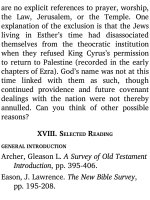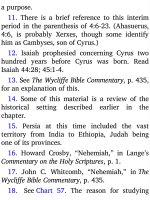Jensens survey of the old testament adam 134
Bạn đang xem bản rút gọn của tài liệu. Xem và tải ngay bản đầy đủ của tài liệu tại đây (117.99 KB, 4 trang )
repentance,
confession
of
sin,
and
restitution, so that true worship of God
could be restored. The sin of mixed
marriages (between Israelites and the
heathen) was a major de lement at this
time. How did this sin a ect the religious
life of Israel?
13. Observe, from the dates shown on the
chart, the duration of the time between
chapters 6 and 7. Consult Chart 57, and note
that the book of Esther is located in this
period.
14. The names of the three important
kings of Persia—Cyrus, Darius, and
Artaxerxes—are placed on the chart where
they relate to the story.
15. In chapters 4-7, Ezra records much of
the o cial correspondence involving the
kings’ o ces and having to do with the
Jews’ permission to return to Canaan.
Originally these letters were written in
Aramaic, which was the o cial language of
diplomatic discourse in those days. Ezra
preserved the letters in their original
Aramaic form. This is one of the few
Aramaic sections in the Hebrew Bible.
Identify the sender and addressee in each
case: 4:11-16; 4:17-22; 5:7-17; 6:6-12; 7:1126.
16. Compare the two sections identi ed
on the chart as The Work. Why were these
activities important in the life of the Jews?
IV. PROMINENT SUBJECTS OF EZRA
(chaps. 1-6)
A simple outline shows the content of this
first half of the book.
A. RESTORATION UNDER ZERUBBABEL
I. The Journey (1:1—2:70)
A. Decree of Cyrus (1:1-4)
B. Preparations for the Journey
(1:5-11)
C. List of Returning Exiles (2:1-70;
scan Neh 7:5-73 for a similar list)
II. The Work (3:1—6:22)
Work Begun (3:1-13)
(536 B.C.)
Work Opposed (4:1-24)
(534
Work Resumed (5:1—6:12)
(520 B.C.)
Work Finished (6:13-22)
(516 B.C.)
B.C.)
(Locate the above four dates on Chart 57.)
The last two verses of the above section
could be called key verses for Ezra. They
summarize the rst return of Jewish exiles
from captivity in 536 B.C., with the aid of
God and through the favor of an Assyrian
king (6:21-22). When the core is extracted
from these verses, a bright note of gladness
is the emphasized concluding message: “The
sons of Israel … ate … with joy, for the LORD
had caused them to rejoice.”
(chaps. 7-10)
As the survey Chart 59 shows, the subject
of these chapters is similar to that of the
first half of the book. The two main parts are
“The Journey” (7:1—8:32), and “The Work”
(8:33—10:44).
1. The journey (7:1—8:32). (Study the
section with the following four points in
view.)
a) The permission (7:1-26)
b) The psalm (7:27-28)
c) The people (8:1-14)
d) The pilgrimage (8:15-32)
About sixty years transpired between
chapters 6 and 7. They were probably years
of spiritual decline for Jews in Judah. The
coming of Ezra the scribe with a second
contingent of returning exiles was very
timely, for Ezra was a man of God who had
B. REFORMS UNDER EZRA









